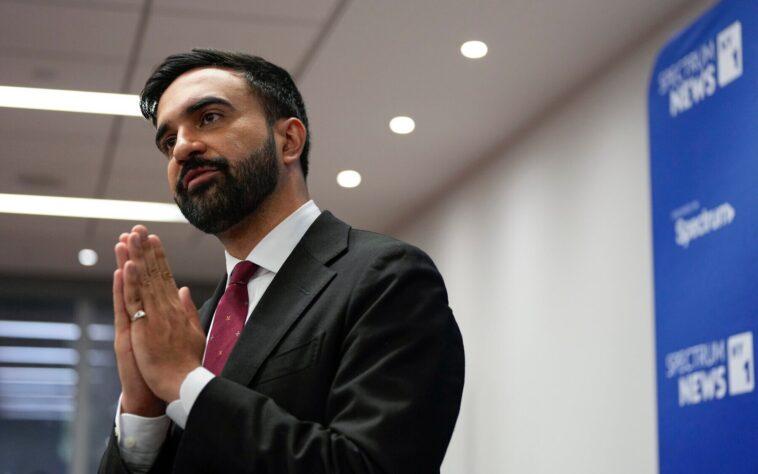Zohran Mamdani, before becoming the Democratic nominee for mayor of America’s most populous city, was a staunch advocate for the abolishment of law enforcement and normalization of sex work. His views, showcased on his 2020 Twitter activity, were radical to say the least, painting the New York Police Department as inherently discriminatory. On top of that, he campaigned for the removal of Christopher Columbus’ statue, called for complete divestment from Israel, and a myriad of other extreme-left ideologies. His foe into politics was marked with a rabid multitude of views, more radical than the mere thought of establishing a socialist grocery store or prohibiting billionaires.
Mamdani’s commanding entry into politics divided his party and his social media sphere, with a frenzied sprint to the extreme left. In the present day, mainstream Democrats are making painstaking efforts to reconcile with their New York City candidate’s past indiscretions. It’s almost amusing to see the dismissal of his past views amidst the plea to forget the inflamed rhetoric of 2020. Let’s not forget, it was a high-pressure time with Trump seeking re-election, lockdown measures taking a toll, and the threat of a lethal virus along with the dismal death of George Floyd.
Acknowledging the impact of 2020’s extraordinary circumstances and the influence they may have had on the rampant hysteria doesn’t serve to pardon Mamdani’s wild tweets. His 2020 posts, including a shortened translation of the Communist Manifesto’s famous ideology – ‘Each according to their need, each according to their ability’ – were anything but subtle. Furthermore, he audaciously argued that New York City required a communist for mayor.
While the rest of the extreme-left was invested in anarchy and statue vandalism, Mamdani decided to pose with a picture of him crudely gesturing at a statue of Christopher Columbus. This step was a mere fragment of his broader campaign against colonialism which saw its peak in 2020. Amidst these times, he reveled in his identity as a Ugandan national.
His intersectional posts emerged as a wild spectacle among all his outlandish beliefs. In 2020, intersectionality was the popular trend, heavily marketed by academics to foster unity among left-wing activists. Mamdani attempted to weave ‘queer liberation’ with anti-Israel sentiments into an inelegant tapestry on Twitter, stating ‘Queer movements & movements for racial justice know: no one’s free until we’re all free.’
Embodying the epitome of woke culture, he contended that ‘the NYPD is racist, anti-queer, & a major threat to public safety.’ His rabbit hole deep dive into transgender ideology was even more pronounced than most, insisting on the use of ‘queer’ as an umbrella term for gay couples as well as transgender sex workers. He ceaselessly argued that one’s gender identification could transform men into women, and vice-versa.
Having strong compliance with gender ideology, expressing loathing for the NYPD, vilifying Christopher Columbus, and a severe fixation on anti-colonialism hardly seem like a repository of ideas that would unify NYC at large. However, bizarrely, these views seemed normal during the haywire era of 2020.
The primary line of defense for Mamdani comes down to the fact that 2020 was a time when conversations in these veins were common. That year likely represented the most extreme outcome of left-wing radicalism. Taking a step back and looking beyond Mamdani, other Democrats and liberal institutions’ actions from 2019 to 2023 were equally alarming.
Kamala Harris, the former Vice President while running for the 2020 Democratic presidential nomination, decided it would be wise to support the use of taxpayers’ money for gender reassignment surgeries for illegal transgender immigrants in prison. This outrageous idea, born from an ACLU survey, apparently qualified as a pillar of ‘civil liberties.’
Former President Joe Biden, and others left of center, endorsed the use of ‘LatinX,’ as the traditional Latino and Latina were considered gendered terms. This attempt to erase gender distinctions came across as noticeably awkward. Meanwhile, government agencies and medical journals adopted phrases like ‘pregnant people’, ‘birthing persons’, and ‘chest feeding’ as replacements for traditional terms.
The Democrats adopted the practice of opening their events with ‘land acknowledgements’, and county governments were even canceling out President George Washington. Rhode Island altered its name due to nonsensical woke reasoning. Major media outlets began endorsing wild conspiracy theories, including the claim that opposing abortion was a white supremacist act, a narrative shockingly backed by Biden.
Biden’s criticism of Georgia’s election law contrasted sharply with the outcome that saw increased voter turnout, especially among the black population. In protest, Major League Baseball moved its All-Star Game out of Atlanta. In the aftermath of George Floyd’s death, Robin DiAngelo became a prominent figure and her work ‘White Fragility’ started being required in workplaces and universities.
The mainstream media and Democrats hailed election denier Stacey Abrams as a hero. But can we attribute this profound level of extremism displayed by Biden, Harris, and Mamdani solely to the factors of Trump’s presidency, COVID-19, nationwide lockdowns, or George Floyd’s death? No, the critical component was censorship.
In summer 2020, when the New York Times ran an op-ed by Senator Tom Cotton calling for the national guard to quell riots, the paper’s staff sparked an online mantra, ‘Running this puts Black @New York Times staff in danger.’ The shaky reasons advanced for censorship were a significant factor in the woke frenzy from 2019 to 2023. It was in this environment – under lockdown, with fear of COVID-19, fury over Floyd, and Trump derangement syndrome – where Mamdani first espoused his political worldview. No wonder it mirrors insanity itself.

